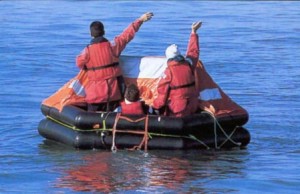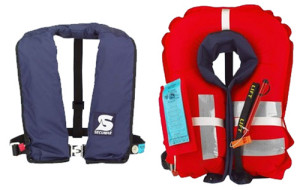How Do Inflatable Life Rafts Work
Inflatable life rafts are stored visibly on board a vessel in either canvas holdalls, fibreglass containers, or all-weather synthetic plastic carry cases.
The rafts themselves are made of corrosion- and abrasion-resistant, polyurethane-coated nylon, a super-tough but light material.
The standard inflatable life raft can be launched by throwing it overboard and climbing in or by lowering it into the water using a mechanical winch on the side of the vessel, called a davit. If passengers tug on the ‘painter’ – the cord that releases compressed gas from a canister into the raft – the dinghy will inflate in a matter of seconds.
However, they can also be deployed by hydrostatic release units (or HRUs), which connect the sealed life raft container to the vessel’s deck.
When the boat starts to sink, water pressure triggers the HRU to sever the main tie binding the raft to the deck. As it sinks, more tension is placed on the painter until it eventually gives way, releasing gas into the buoyancy chambers.
Choosing the Best Life Raft – Mailspeed Marine
Inflatable life raft vs proactive self-rescue boat
The main features of an inflatable life raft
 Canopy – Made of a tough, coated rubber material, the canopy protects the occupants from the elements, including wind, rain and sea-spray.
Canopy – Made of a tough, coated rubber material, the canopy protects the occupants from the elements, including wind, rain and sea-spray.
Boarding ladder – On the side of the raft there is an opening for stricken passengers to enter via a small rope ladder that’s made from nylon straps.
Inflation system – Life rafts that are inflated manually have a long cord called a painter, which the user pulls on. This forces a plunger through the seal of an attached gas canister, releasing non-reactive pressurised gas into the buoyancy chambers.
Exterior strobe light – Light beacons on top of the canopy make the life raft easier for rescue vessels/planes to see at night. Some rafts come equipped with transponders that give out radio waves and the emergency pack will often Include high-intensity lights to make survivors more visible too.
Arch tubes – Usually also inflatable, these structural arches. which are inflated via the upper buoyancy chamber, support the raft’s protective canopy. Non-ret urn valves ensure that even If the upper buoyancy chamber bursts this essential framework will not collapse.
Exterior and interior life lines – These durable life lines are to be gripped during bad weather. Other items attached to the outside of the craft include a sea anchor (or drogue), a rescue quoit and a buoyant knife.
Buoyancy chambers – The raft typically has two separate inflatable floors, so in case of a puncture there is still some buoyancy to keep afloat. These chambers can be pumped up and deflated manually too.
Ballast compartments – A collection of ballast bags beneath the craft help to prevent capsizing by weighing the boat down sufficiently. These bags have large holes in the top to help them fill quickly with a suitable volume of seawater.
What are Inflatable Life Jackets Made Of
 Inflatable life jackets consist of one or more internal bladders that are inflated in an emergency. They can be manually operated or automatically triggered.
Inflatable life jackets consist of one or more internal bladders that are inflated in an emergency. They can be manually operated or automatically triggered.
Manual systems require the user to pull a lanyard that causes a mechanism to puncture a canister of carbon dioxide (CO2) gas, which then expels to rapidly inflate the bladder. The whole process takes just three seconds to fully inflate the life jacket.
Automatic life jackets also have CO2 gas canisters inside them to inflate the bladder. They come in two forms. The first has a firing pin that is held in place by a small pellet.
Five Inflatable Life Jacket Myths: Do You Know
When the pellet hits the water it quickly dissolves and triggers the firing pin, causing the gas from the canister to be released and therefore inflating the jacket.
The second type is the hammer or hydrostatic jacket, which has a pellet enclosed in casing linked to a hydrostatic valve.
The valve will only open to dissolve the pellet, and then fire the gas canister, when it is a few centimeters below the surface of the water.
Automatic life jackets usually have a manual trigger mechanism as a backup, and all life jackets have a tube to enable the user to blow the jacket up if all else fails.
